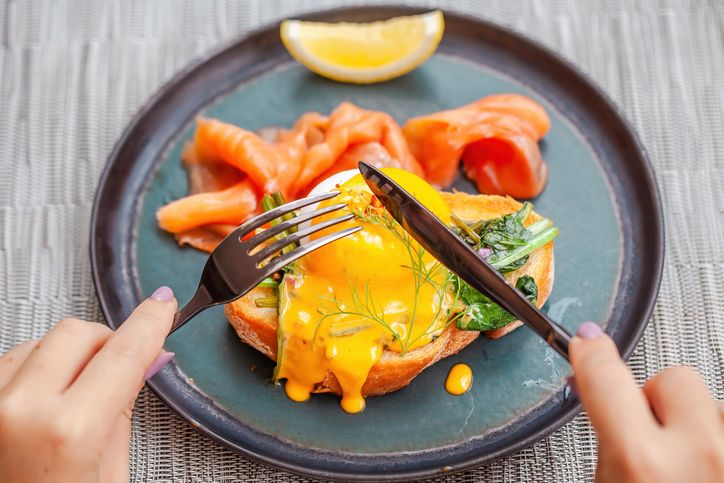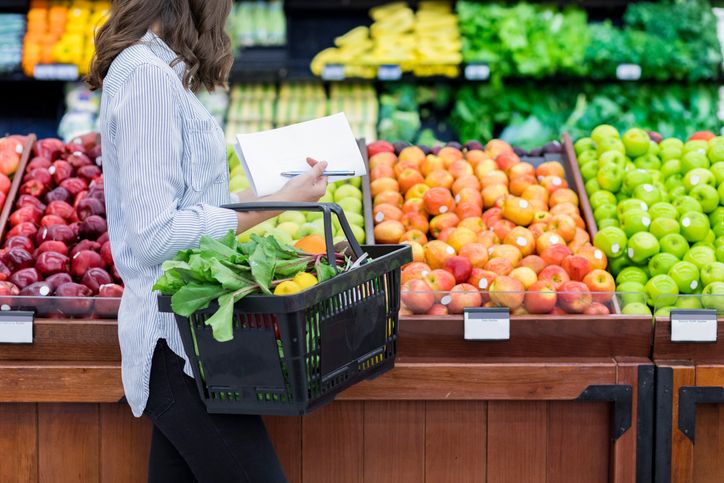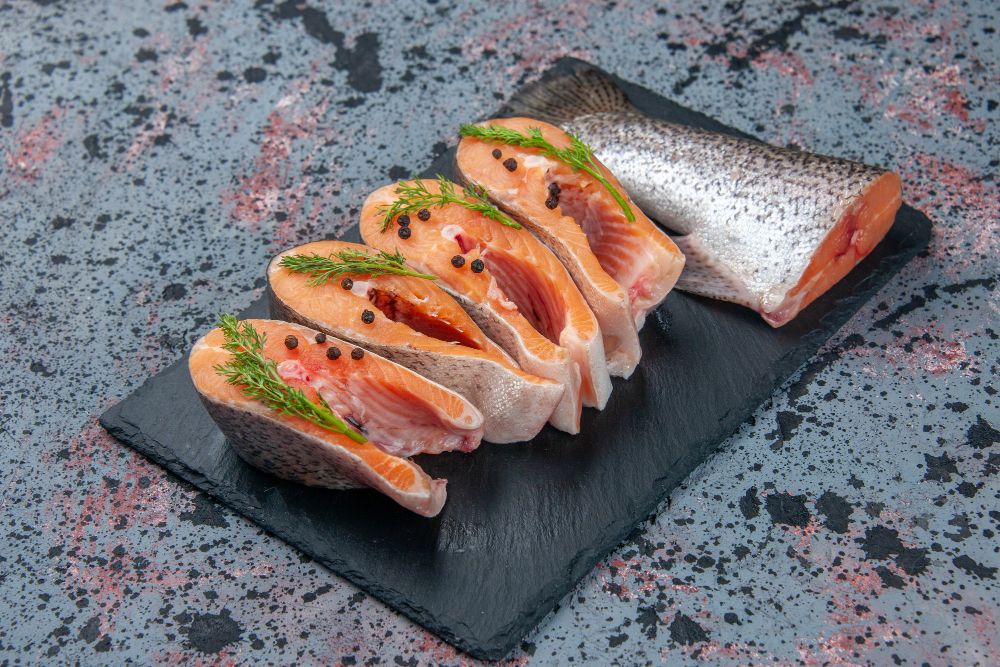
Author: Natalie Ng|Updated: 8 May 2025
If you're following a vegan diet but not seeing the results you expected, it can feel confusing. A plant-based lifestyle has a lot of health benefits, but it’s still possible to gain weight—especially if some common habits go unchecked. Processed vegan foods, oversized portions of healthy fats like peanut butter or olive oil, and too many high-calorie plant-based snacks can all slow down weight loss. Even healthy ingredients like whole grain bread or sweet potato can work against your goals if you're not keeping an eye on calorie intake. A vegan diet can support your weight loss journey, but small choices add up fast. The way you build your meals, your portion sizes, and even your idea of “healthy” can all make a difference. Keep reading to learn how to avoid these mistakes and build a simple, balanced vegan meal plan that supports your nutrition goals and helps you lose weight—without cutting corners on taste or health benefits.

Overreliance on Processed Vegan Foods

Processed Doesn't Always Mean Healthy
Many vegan products look healthy but are high in calories and low in fiber. Items like vegan cheese, plant-based nuggets, and frozen meals often contain refined oils, added sugars, and sodium. These ingredients can lead to weight gain, especially if you eat them regularly without tracking your calorie intake.
Why It Slows Down Weight Loss
Processed vegan foods are usually low in volume but high in calories. That means you might feel hungry soon after eating, which makes it easy to snack more throughout the day. This pattern can increase your total calories without you realizing it, slowing progress on your weight loss journey.
Even “healthy” vegan snacks like whole wheat crackers or granola bars can add up fast if you’re not careful. While they may fit into a vegan meal plan, they don’t always match your nutrition goals.
What To Eat Instead
Build your meals around whole foods like cooked quinoa, sweet potato, canned chickpeas, kidney beans, and vegetables like red pepper or cherry tomatoes. These foods are higher in fiber, which helps you feel full and supports a high fiber diet. They also contain the macronutrients your body needs, including protein from plant based proteins like edamame pods or hemp seeds.
Batch meal prep can also help. Making a few servings of a 7 day vegan meal in advance can reduce your reliance on packaged meals. A simple meal using brown rice, red onion, olive oil, and 1 cup of vegetables can be more filling than a frozen vegan dinner with the same calories.
Stick to whole grain bread, whole wheat tortillas, and legumes to keep meals satisfying. You can still include your favorite packaged vegan options—just treat them as an occasional part of your week, not your foundation.

Portion Control Problems With Healthy Foods

Why “Healthy” Doesn’t Always Mean “Low-Calorie”
Foods like nuts, seeds, avocados, and dried fruits are nutrient-rich, but they’re also calorie-dense. Just 1 serving—like 1 4 cup of almonds or 1 tbsp of peanut butter—can add 150 to 200 calories to your daily intake. If you’re not measuring these ingredients, your vegan weight loss meal plan can quickly go off track.
Dried fruits are another example. While they offer some vitamins and fiber, they’re concentrated in sugar and calories. A handful of raisins or dates might seem small, but it can contain the same calories as a full bowl of fresh fruit.
Healthy Fats: Eat, Don’t Overeat
Fats from plant-based sources like olive oil, nuts, and avocados are important for your well being, especially when following a vegan diet. They support brain health, hormone function, and help you absorb fat-soluble vitamins. But these healthy fats can also drive weight gain if you don’t track portions.
For example, 1 tbsp of olive oil contains about 120 calories. That adds up fast if you’re drizzling it over every meal. The same goes for nut butters or a handful of mixed nuts during meal prep or snacking.
Simple Ways To Control Portions
• Use measuring spoons or a food scale when working with calorie-dense foods like chia seeds, hemp seeds, and nut butters
• Balance higher-calorie foods with high fiber options such as leafy greens, cooked quinoa, or legumes like kidney beans and canned chickpeas
• Serve meals on smaller plates or bowls to naturally limit portions without thinking about it
• Include vegetables like red pepper, bell pepper, cherry tomatoes, and edamame pods to bulk up meals without adding too many calories
• Plan your meals using a 7 day vegan meal template so you can keep your calorie intake steady and avoid accidental overeating
Controlling portions doesn’t mean you have to restrict healthy foods—it just means being aware of how much you're eating. That awareness helps you lose weight while still meeting your nutritional needs.
Book Now to Experience
S6 Body Sculpting Treatment
1 Minute Self-Registration
Date should not be before minimal date

Hidden Calories in Plant-Based Drinks
Drinks Can Add More Calories Than You Think
Many plant-based drinks seem like healthy choices, but they can quietly raise your calorie intake. Sweetened almond milk, oat milk lattes, and bottled smoothies often contain added sugars, syrups, or calorie-dense ingredients like coconut cream. These extras can make your efforts to lose weight harder without you realizing it.
For example, 1 cup of sweetened oat milk may contain around 120 calories—more than plain soy or almond milk. Coconut milk used in drinks can be even higher, with some versions reaching over 400 calories per cup due to their high fat content.
Café Orders and Bottled Drinks
Trendy café orders can be some of the biggest offenders. A matcha latte with coconut milk and agave syrup might seem like a light drink, but it can pack 300 calories or more. Green juices and smoothies might include calorie-heavy fruit purées, nut butters, or sweetened plant milks, which can be hard to track without checking the ingredients.
Even protein shakes and vegan meal replacements can contain hidden calories if you don’t measure ingredients. Adding 1 tbsp of peanut butter or 1 2 cup of oats might seem harmless, but doing that daily adds hundreds of calories each week.
How To Keep It Simple
• Choose unsweetened plant milks like almond, soy, or oat for your vegan meal plan
• Read labels carefully for added sugars, syrups, and oils
• Make your own smoothies at home with whole foods like frozen banana, spinach, cooked quinoa, or 1 tbsp of chia seeds
• Use lemon juice or fresh fruit to add flavor without extra calories
• Stay hydrated with water, tea, or homemade infused drinks instead of high-calorie options
Being mindful of your drinks is just as important as your meals. By watching the calories in your beverages, you keep your weight loss journey on track without giving up variety.

Mindless Snacking on Vegan Treats

Snacking Without Thinking Adds Up Fast
It’s easy to snack more than you realize, especially when the snacks are labeled as healthy or vegan. Vegan cookies, granola bites, roasted nuts, and even dried fruits may seem like smart choices, but they can be high in sugar, oil, and calories. You might snack on them throughout the day without noticing how much you’re eating.
Even nutrient-rich options like nuts and seeds can lead to weight gain if you don’t portion them. For example, 1 4 cup of trail mix or 1 tbsp of peanut butter can contain over 150 calories. When you graze on these foods, it’s hard to track your total calorie intake accurately.
Why Vegan Doesn’t Mean Low-Calorie
Vegan snacks can still include processed ingredients, sweeteners, and added oils. Vegan protein bars, dairy-free chocolates, or baked goods made with coconut oil or almond flour might fit your plant based diet, but they don’t always support weight loss.
Snacking straight from the package or keeping snacks in sight makes it even easier to eat more than you planned. These habits can slow your progress, even if your main meals are balanced.
Smarter Snacking Habits
• Portion snacks ahead of time using small containers or zip bags
• Choose high fiber foods like fresh vegetables, veggie sticks, or 1 cup of cherry tomatoes
• Pair snacks with protein, like edamame pods or canned chickpeas seasoned with lemon juice
• Set regular snack times instead of eating while working or watching TV
• Track what you eat to stay aware of your habits and keep your vegan weight loss meal plan on target
By planning your snacks the same way you plan meals, you’ll stay full between lunch and dinner without overdoing it.

Missing Essential Nutrients for Metabolism
Why Nutrient Gaps Can Affect Weight
A vegan diet can meet all your nutritional needs, but missing certain nutrients can slow your metabolism and make it harder to lose weight. Even if you’re eating enough calories, lacking key nutrients may affect how your body uses energy and stores fat.
Some nutrients—like vitamin B12, iron, and iodine—are harder to get from plant-based foods. If you’re not paying attention to these, your body might not function at its best, which can affect your weight loss progress over time.
Key Nutrients to Watch and Their Sources
Focusing on nutrient-rich foods in your vegan meal plan helps support metabolism and overall well being. Here are a few nutrients that matter and where to get them:
Vitamin B12
• Fortified foods like plant milk, nutritional yeast, and breakfast cereals
• A B12 supplement may be necessary for most vegans
Iron
• Lentils, pumpkin seeds, cooked spinach, and canned chickpeas
• Combine with vitamin C-rich foods (like red pepper or lemon juice) to improve absorption
Zinc
• Hemp seeds, kidney beans, oats, and whole grain bread
Iodine
• Iodized salt and seaweed (in small amounts)
Vitamin D
• Sunlight exposure, mushrooms exposed to UV light, and fortified plant milks
How to Stay On Track
• Use a weekly or 7 day vegan meal to plan meals that include these nutrients
• Rotate whole foods like sweet potato, cooked quinoa, and leafy greens into your meals
• Track nutrients just as you would calories or protein to support your weight loss journey
• Speak to a registered dietitian to check your intake and decide on supplements
Covering your nutritional bases will help your metabolism work efficiently and support healthy weight management long term.
High-Calorie Foods at Vegan Restaurants
Why Dining Out Can Slow Progress
Vegan restaurant meals often seem healthy, but many of them are high in calories. Dishes may use generous amounts of oil, nuts, seeds, and creamy sauces to enhance flavor and texture. These ingredients are part of a balanced vegan diet, but when restaurants use them in large amounts, it’s easy to exceed your calorie needs without realizing it.
Even popular meals like Buddha bowls, vegan burgers, or plant-based curries can contain more calories than expected. A vegan burger made with lentils and topped with vegan cheese, avocado, and sauce on whole grain bread might sound wholesome—but it can still deliver over 800 calories in one serving.
What to Watch For
• Fried vegetables coated in oil or batter
• Coconut milk-based sauces in curries or soups
• Large amounts of nuts, seeds, or olive oil in salads and bowls
• Vegan desserts made with dates, almond flour, or nut butters
• Large servings of rice or pasta without balancing vegetables and protein
Even whole foods can cause weight gain if portions aren’t controlled. A dish with brown rice, kidney beans, and avocado is healthy, but a double serving of each adds up quickly.
How To Make Better Choices
• Ask how dishes are prepared and request sauces or dressings on the side
• Share meals or ask for a takeaway container before eating
• Choose dishes with more vegetables and fewer calorie-dense toppings
• Use your regular meal plan as a guide to stay within your usual calorie intake
• Stick to 1 serving of starchy sides like 1 cup of cooked quinoa or 1 2 cup of corn kernels
Eating out doesn’t have to disrupt your weight loss goals if you pay attention to portions and ingredients.
Book Now to Experience
S6 Body Sculpting Treatment
1 Minute Self-Registration
Date should not be before minimal date

Emotional Eating With Vegan Comfort Foods
Eating for Comfort, Not Hunger
Switching to a vegan diet doesn’t automatically change emotional eating habits. Stress, boredom, or low mood can still lead to eating—especially comfort foods. Vegan ice cream, dairy-free mac and cheese, and chocolate desserts may feel like better choices, but they’re still high in sugar, fat, and calories.
You might tell yourself it’s fine because the food is plant based. But calories from processed vegan treats count just the same as any other food. If you eat for emotional reasons rather than hunger, it can make weight loss more difficult.
Why It’s Easy to Overeat
Comfort foods are often rich, sweet, or creamy—things that trigger pleasure and satisfaction. A few spoonfuls of vegan chocolate mousse or a slice of cake with almond flour and peanut butter can quickly add hundreds of calories. If you're not paying attention to portion sizes or hunger cues, these foods can easily become part of your daily routine.
What You Can Do Instead
• Recognize patterns—note when you eat out of habit or mood instead of hunger
• Use non-food options like going for a walk, calling a friend, or writing down your thoughts
• Keep comfort foods in small amounts and portion out 1 serving rather than eating from the package
• Focus meals around whole foods like sweet potato, brown rice, legumes, and vegetables
• Build your vegan meal plan around structure and consistency to reduce mindless eating
Emotional eating can affect your weight even if the food is vegan. Paying attention to why and how you eat helps you stay on track and maintain better eating habits.

Sample 7 Day Vegan Meal Plan for Weight Loss

Day 1
Breakfast Overnight oats with 1 2 cup rolled oats, 1 tbsp chia seeds, unsweetened almond milk, and 1 2 cup fresh berries
Lunch Salad with canned chickpeas, cherry tomatoes, cucumber, red onion, lemon juice, and 1 tbsp olive oil 1 slice of whole grain bread
Dinner Stir-fry with tofu, broccoli, bell pepper, edamame pods, and cooked quinoa (1 cup) Sauce: low-sodium soy sauce, garlic, and ginger
Snack 1 medium apple with 1 tbsp peanut butter
Day 2
Breakfast Smoothie with spinach, 1 2 banana, 1 tbsp hemp seeds, unsweetened soy milk, and 1 4 cup oats
Lunch Lentil and veggie soup with whole wheat pita (1 serving)
Dinner Sweet potato (1 medium) topped with black beans, avocado (1 4), corn kernels, and red pepper
Snack Veggie sticks with 2 tbsp hummus
Day 3
Breakfast Chia pudding made with 1 4 cup chia seeds, unsweetened almond milk, and diced mango
Lunch Brown rice bowl with kidney beans, steamed kale, carrots, and tahini-lemon dressing
Dinner Whole wheat tortilla filled with sautéed mushrooms, zucchini, and firm tofu
Snack Handful of roasted edamame or pumpkin seeds (1 serving)
Day 4
Breakfast Toasted whole grain bread with mashed avocado (1 4), hemp seeds, and red pepper flakes
Lunch Chickpea salad sandwich with mashed canned chickpeas, mustard, chopped celery on whole wheat bread
Dinner Lentil curry with cauliflower and spinach, served with 1 2 cup cooked quinoa
Snack 1 2 cup mixed berries with a few almonds
Day 5
Breakfast Tofu scramble with red onion, bell pepper, spinach, and turmeric, served with a slice of whole wheat toast
Lunch Roasted sweet potato and black bean bowl with avocado and salsa
Dinner Pasta made with whole wheat noodles, cherry tomatoes, spinach, and a homemade cashew sauce
Snack 1 tbsp peanut butter with banana slices
Day 6
Breakfast High fiber cereal with unsweetened almond milk, topped with 1 tbsp chia seeds and fresh fruit
Lunch Grain bowl with cooked quinoa, grilled zucchini, chickpeas, and a lemon juice dressing
Dinner Vegan chili with kidney beans, corn, red pepper, and diced tomatoes
Snack 1 2 cup edamame pods
Day 7
Breakfast Smoothie bowl with frozen berries, banana, unsweetened soy milk, and 1 tbsp hemp seeds
Lunch Hummus and veggie wrap using whole wheat tortilla, filled with shredded carrots, cucumber, and spinach
Dinner Baked tofu with roasted vegetables and 1 2 cup brown rice
Snack 1 cup cherry tomatoes with sea salt and basil

Boosting Vegan Weight Loss with S6 Body Sculpting Treatment
Even with a well-structured vegan weight loss meal plan, some areas of body fat can be hard to lose. Eating clean, choosing whole foods, and staying within your calorie intake can help reduce weight overall—but spot reduction remains a challenge. That’s where treatments like S6 Body Sculpting can support your progress.
What Is S6 Body Sculpting Treatment?
S6 Body Sculpting is a non-invasive, non-surgical treatment designed to help reduce stubborn fat in specific areas like the belly, waist, thighs, arms, calves, and lower buttocks. It uses low-energy bio-laser technology to break down fat cells and vacuum suction to speed up fat removal through the body’s natural metabolic processes.
During treatment, a probe delivers laser energy deep into the subcutaneous fat layer. This energy breaks down fat cells, which are then flushed out through the lymphatic system. At the same time, the treatment stimulates collagen production to firm and tighten the skin.
How It Works Alongside a Vegan Meal Plan
A vegan meal plan built around whole grains, vegetables, plant based proteins, and healthy fats helps with gradual, steady weight loss. But some areas—like the lower belly or back—might still hold onto fat due to genetics or lack of targeted movement.
S6 Body Sculpting complements your diet by focusing on those stubborn spots. While your meal prep and nutrition goals handle overall calorie control, the treatment helps shape your figure more precisely by addressing fat pockets that food alone can’t target.
Benefits of the Treatment
• Non-surgical and involves no downtime—get back to your routine immediately after each session
• Targets seven key fat-prone areas, including the belly, back, and thighs
• Helps speed up your metabolism, enhancing the effects of your plant based diet and meals
• Promotes collagen production to tighten the skin while reducing fat, preventing sagging
• Suitable for many body types—especially useful for those managing weight through a 7 day vegan meal plan or high fiber diet
Pairing your vegan weight loss journey with S6 Body Sculpting can improve your results, especially when you're already focused on portion control, protein needs, and balanced eating.
Book S6 Body Sculpting today to support your weight loss goals and target stubborn fat areas effectively.Book Now to Experience
S6 Body Sculpting Treatment
1 Minute Self-Registration
Date should not be before minimal date
FAQ
1. What should I avoid in a vegan diet if I want to lose weight?
To lose weight on a vegan diet, avoid highly processed vegan foods such as plant-based snacks loaded with oil, sugar, or artificial ingredients. Limit your intake of vegan cheese, sweetened plant milks, and packaged meat substitutes that can be high in calories and low in fiber. Stick to whole foods like vegetables, whole grains, and plant based proteins to meet your nutrition goals without going over your calorie intake.
2. Can I get enough protein from a vegan weight loss meal plan?
Yes, you can meet your protein needs on a vegan diet by including foods like canned chickpeas, kidney beans, lentils, tofu, edamame pods, cooked quinoa, and hemp seeds. These foods not only provide protein but also support muscle retention during weight loss. A high fiber diet with adequate protein is essential for feeling full and maintaining a healthy body mass index.
3. How do I avoid feeling hungry on a vegan diet?
To avoid constant hunger, focus on high fiber foods that digest slowly and keep you full for longer. Include 1 cup of vegetables at every meal, choose whole grains like brown rice or whole grain bread, and add healthy fats such as 1 tbsp of olive oil or peanut butter. Balanced meals with protein, carbohydrates, and fats help regulate appetite and support your weight loss journey.
4. Is a vegan weight loss meal plan suitable for daily meal prep?
Yes, a 7 day vegan meal plan is perfect for meal prep. You can prepare foods like roasted sweet potato, lentil stews, whole wheat pasta dishes, and veggie stir-fries in advance. Store your meals in containers to control portions and reduce the chance of overeating. This makes it easier to stay on track with your calorie intake and maintain steady progress.
5. What are some overlooked ingredients that support vegan weight loss?
Many people forget about simple additions like lemon juice, red onion, or 1 tbsp of chia seeds that can add flavor, fiber, and nutrients without extra calories. Other useful ingredients include whole wheat tortillas, 1 medium avocado (used in small amounts), and 1 2 cup of corn kernels. These help create meals that are satisfying, nutritious, and aligned with your weight loss goals.
Recommended Articles
COPYRIGHT© NEW BEAUTY MANAGEMENT LIMITED 2025. ALL RIGHT RESERVED.




